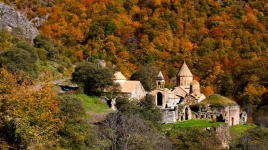Dadivank
Wednesday, October 27, 2021
Dadivank is an Armenian monastery. It was built between the 9th and 13th centuries.
The monastery was founded by St. Dadi, a disciple of Thaddeus the Apostle who spread Christianity in Eastern Armenia during the first century AD. However, the monastery was first mentioned in the 9th century. In July 2007, the grave of St. Dadi was discovered under the holy altar of the main church. The princes of Upper Khachen are also buried at Dadivank, under the church's gavit.
The Monastery belongs to the Artsakh Diocese of the Armenian Apostolic Church, and consists of the Cathedral church of St. Astvadzadzin, the chapel and a few other buildings. The main church has Armenian script engraved into its walls, in addition to several 13th-century frescoes. The bas-relief on the south facade of the cathedral at Dadivank, built in 1214, shows the princess offering the church in memory of her sons. According to Paolo Cuneo, Dadivank is one of two Monasteries along with Gandzasar where bust motifs (possibly the donors of the monasteries) can be found.
Modern period
In 1994, following the end of the First Nagorno-Karabakh War, the monastery was reopened, and in 2004, a renovation process began with funding from Armenian-American businesswoman Edele Hovnanian, ending in 2005. The restoration efforts restored the cathedral, along with a chapel which was restored by Edik Abrahamian, an Iranian-Armenian from Tehran.
On 8 October 2001, a motion was proposed at the Parliamentary Assembly of the Council of Europe on behest of sixteen parliamentary members on the "Maintenance of historical and cultural heritage in the Nagorno-Karabakh Republic". The motion cited as an example "the destruction of Zar (Tsar) monuments in the Kelbajar region, Dadivank, which the local Muslim population regarded as remnants of the Armenian Christian religion and ruined the monastery as it could".
In August 2017, Italian specialists who had previously conducted restoration operations at Davidank returned to continue their cleaning and restoration of the monastery. They had already restored the four chapels and their frescoes and were planning to restore inscriptions and ornaments near the doors to the chapels. The entire restoration project was planned to be completed by 2020.
2020 war and current status
In the aftermath of the Nagorno-Karabakh war in 2020, which resulted in a ceasefire agreement stipulating an Armenian withdrawal from Kalbajar and a return of the surrounding area to Azerbaijan, the monastery was included in the territory to come under Azerbaijani control. The Abbot of the Dadivank Monastery made the decision to transport the monastery's relics of significance, including bells, crosses, and khachkars, to Armenia for protection from destruction. Azerbaijan called it an "illegal activity" and added that it would take action to enforce legal procedures. After the withdrawal of Armenian forces from the region, the monastery was placed under the protection of the Russian peacekeeping forces. However, on 28 November 2020, the Azerbaijani Ministry of Defence released footage from inside the monastery.
On 4 December 2020, representatives of the Udi community of Azerbaijan visited the monastery and performed a prayer inside. The next day, Rafik Danakari, the deputy chairman of the Udi Christian Orthodox community, was appointed preacher at the monastery. A sale-exhibition From Dadivank to Yerevan was held on 16 December at the Museum of Folk Art in the Armenian capital.
In late December additional Armenian clergymen arrived at the monastery and the first wedding ceremony was performed after the war, under Russian peacekeeper protection.





